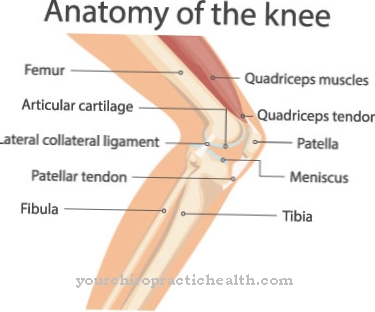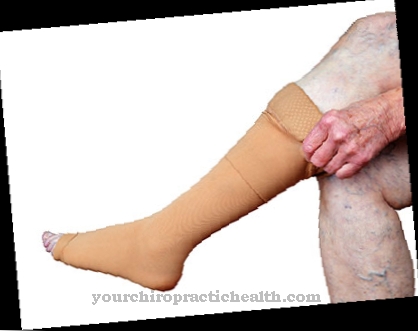As Retroflexio uteri is a backward tilted uterus, which can be either mobile or fixed. Mobile backward tendencies are often associated with pregnancies or age-physiological changes and then have no pathological value. Usually the phenomenon does not require therapy.
What is a retroflexio uteri?

© AGPhotography - stock.adobe.com
The uterus is also called the uterus and is pear-shaped. In its natural anatomy, the organ is usually bent forward in the abdomen and tilts towards the abdominal wall. The uterus is up to four inches long and five inches wide. Significant increase in size is possible during pregnancy.
Around ten percent of women suffer from a backward tilted uterus. This phenomenon will Retroflexio uteri called and lets the organ point in the direction of the sacrum. A retroflexed uterus does not have to have any pathological value and can correspond to a variant of the anatomically normal position that does not cause any symptoms.
As soon as women with the uterus tilted backwards become pregnant, their uterus normally straightens up spontaneously. When the backward tilted uterus is not mobile but fixed. A uterine retroflexion with mobility is called retroflexio uteri mobilis. The fixed variant is called retroflexio uteri fixata. The latter form usually causes discomfort and is therefore a disease.
causes
Mobile forms of uterine retroflexion can be genetic and therefore present from birth. If the tendency to reverse is acquired rather than congenital, then such changes typically correspond to a natural change after pregnancy. Age can also play a role in the mobile form of the backward tilt of the uterus.
The natural changes in age physiology often cause the uterus to change the angle and direction of inclination. Fixed backward uterine tilts have other causes. This phenomenon often occurs in the context of adhesions with a neighboring organ. Endometriosis can also cause this anatomical change.
Focal areas of the uterine mucosa that occur outside the physiologically natural localization are referred to as such. The endometrium is always related to the female cycle. For this reason, endometriosis is usually a phenomenon that occurs as part of the abnormal hormonal action of the cycle. The retroflexio uteri fixata is usually due to hormonal causes.
Symptoms, ailments & signs
A retroflexio uteri is always referred to when the degree of angle between the cervix uteri and the corpus uteri increases. If this angle is enlarged from birth, it is usually a harmless position variant that does not cause any symptoms. In the rarest of cases, those affected suffer from slight pain emanating from the sacrum.
In exceptional cases, dysmenorrhea can be due to a backward tilt of the uterus. As such, cramp-like pains are known during menstruation. If there is a connection, the backward inclination is usually the fixed variant.
The fixed variant can also cause cohabitation pain and thus be responsible for pain during sexual intercourse for women. In extremely rare individual cases, infertility has been observed in connection with retroflexio uteri. Such fertility problems are also most likely to affect women with the fixed form of the backward tilt of the uterus.
Diagnosis & course of disease
The doctor usually makes the diagnosis of retroflexio uteri using imaging techniques such as ultrasound. The increase in the angle of inclination can be seen more or less clearly on the imaging. The finding is often an incidental finding, since the backward tilt of the uterus has so far been asymptomatic.
Only in the rarest of cases do patients see a doctor about pain problems, who then uses imaging to research possible causes and discovers the backward tilt. Asymptomatic and mobile retroflexio uteri in particular have an extremely favorable prognosis. Fixed forms usually go hand in hand with a less favorable prognosis, but can usually be corrected given the current state of medicine.
Complications
There are usually no complications with retroflexio uteri. The backward angled uterus is mostly mobile and can therefore straighten up during pregnancy so that no symptoms occur. However, in rare individual cases symptoms are possible, but they are almost never life-threatening. So it sometimes comes to lower back pain when the uterus is fixed by adhesions and constantly presses against the sacrum.
In addition, cramp-like pain often occurs during menstruation, which is known as a cycle abnormality. So-called cohabitation pain can also occur during sexual intercourse. Some patients even become sterile. However, these complications only occur if the uterus and peritoneum have grown together on the rectum due to inflammatory processes or a so-called endometriosis.
In this case the uterus is firmly fixed and can therefore no longer straighten up even during pregnancy. As a rule, no therapy is necessary for retroflexio uteri. It is usually a harmless positional anomaly of a mobile uterus that occurs in around ten percent of women. To prevent any complications that may arise in the case of a fused and fixed uterus, the adhesions can be surgically removed. However, the adhesions often form again and again.
When should you go to the doctor?
The retroflexio uteri should always be treated by a doctor. As a rule, this disease cannot be treated by means of self-help, so that the patient is always dependent on medical treatment. Self-healing does not occur either.
A doctor should be consulted if the person concerned suffers from pain in the sacrum. This pain can occur sporadically, including pain at rest. Furthermore, those affected very often suffer from pain during menstruation, which can also lead to pain during sexual intercourse. If these complaints occur for no particular reason and do not go away on their own, these complaints should always be examined by a doctor.
As a rule, the retroflexio uteri is treated by a gynecologist or an internist. The life expectancy of the patient is not reduced by the disease. Since the retroflexio uteri can also lead to infertility, psychological treatment can also be useful to counteract psychological complaints. For this, a psychologist should be consulted.
Therapy & Treatment
A retroflexio uteri only requires actual treatment in the rarest of cases. As long as there are no complaints or accompanying symptoms, a correction of the position is usually not necessary. During pregnancy, a mobile, backward-sloping uterus usually straightens up anyway. If the patient so wishes, the doctor can also treat the backward sloping uterus manually and push the organ into the correct position with his hands.
If the manual correction of the position does not succeed, further treatment can possibly take place. This treatment corresponds to a surgical procedure in which the doctor erects the oran. However, this step is only taken if the phenomenon causes serious complaints or is associated with adhesions.
During the operation, the doctor separates the adhesions in order to restore the uterus to its original mobility. If the twisted uterus is associated with infertility, the infertility will be monitored after the operation and ideally should be resolved by correcting the position. If it persists, there may not have been a causal relationship to the retroflexio uteri and the infertility needs further research and treatment after the operation
prevention
Up to 20 percent of all women are affected by retroflexio uteri. A congenital positional anomaly cannot be prevented. The acquired form in the context of age-physiological or pregnancy-related changes can be prevented to a certain extent. For example, there is speculation about the extent to which regular pelvic floor exercises keep the uterus in the right position by tightening the surrounding muscles.
Aftercare
There are no special follow-up and preventive measures for congenital retroflexio uteri. However, if the anomaly has developed gradually, targeted measures are available to the women concerned to improve their situation. Therapy using pelvic floor exercises is considered to be relatively promising.
This should strengthen the surrounding muscles of the uterus and thus ensure a tightening. In most cases, if the symptoms were caused by pregnancy, they then resolve on their own. This could be an indication that regular gymnastics are actually helpful. Once the uterus has recovered from the backward tilt to its normal position, further treatment is unnecessary.
The patients thus have the option of performing physiotherapy at home in accordance with the doctor's advice. If this exercise does not lead to regression, there are other options available, for example the use of a pessary. For the patients who suffer from pain in connection with the deformity, there are gentle pain relievers from natural medicine.
You should take these exactly as directed by your doctor. Gentle massage units and warm baths also help to reduce the discomfort. The women should watch their bodies closely and, if in doubt, consult their doctor in order to counteract any complications in good time.
You can do that yourself
The retroflexio uteri usually regresses by itself. In the course of pregnancy, the backward tilt of the uterus dissolves and does not have to be treated independently. This process can be supported by targeted pelvic floor exercises and comparable measures from the field of physiotherapy. It is best for the patient to discuss any accompanying measures with the gynecologist or a physiotherapist.
If the retroflexio uteri does not resolve by itself, a pessary must be inserted. In the fixed form of the retroflexio uteri, an operation is necessary. After the procedure, the patient should not exercise for a few days. The symptoms should subside on their own within a week.
In the event of pain, natural painkillers from homeopathy can be used as an alternative to the medically prescribed drugs. For example, preparations such as the soothing St. John's wort and various globules can be used. The pain can be relieved by gentle massages in the affected area, but also by warm baths. If the symptoms persist, the gynecologist must be consulted. The backward tilt of the uterus may not have completely resolved or there may be another complication that needs to be clarified.













.jpg)

.jpg)
.jpg)











.jpg)